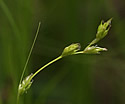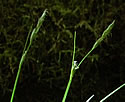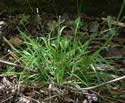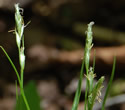Carex deweyana (Dewey's Sedge)
| Also known as: | Round-fruited Short-scaled Sedge |
|---|---|
| Genus: | Carex |
| Family: | Cyperaceae (Sedge) |
| Life cycle: | perennial |
| Origin: | native |
| Habitat: | part shade, shade; dry to moist; mixed and deciduous woods, wetland edges, shaded shores |
| Fruiting season: | June - July |
| Plant height: | 6 to 36 inches |
| Wetland Indicator Status: | GP: FACU MW: FACU NCNE: FACU |
| MN county distribution (click map to enlarge): |  |
| National distribution (click map to enlarge): |  |
Pick an image for a larger view. See the glossary for icon descriptions.
Detailed Information
Spikes: 
![[photo of flowering spikes]](/udata/r9ndp23q/pd3/carex-deweyana-10-8372-4-t.jpg) 2 to 6 stalkless spikes, all essentially alike, the lowest typically well separated from the one above by as much as 1 1/3 inch, the uppermost spikes more closely crowded and may be overlapping. The spike at the tip of the stem has 1 to a few staminate (male) flowers at the base and 7 or more pistillate (female) flowers at the tip (gynecandrous); the remaining spikes are usually gynecandrous, occasionally all-pistillate. At the base of the lowest spike is a narrow, leaf-like or bristle-like bract that is much longer than the attending spike but does not over-top the terminal spike. The stem is mostly erect at flowering time but in time angles from the lowest spike, becoming nodding from that point.
2 to 6 stalkless spikes, all essentially alike, the lowest typically well separated from the one above by as much as 1 1/3 inch, the uppermost spikes more closely crowded and may be overlapping. The spike at the tip of the stem has 1 to a few staminate (male) flowers at the base and 7 or more pistillate (female) flowers at the tip (gynecandrous); the remaining spikes are usually gynecandrous, occasionally all-pistillate. At the base of the lowest spike is a narrow, leaf-like or bristle-like bract that is much longer than the attending spike but does not over-top the terminal spike. The stem is mostly erect at flowering time but in time angles from the lowest spike, becoming nodding from that point.
Leaves and stems: 


![[photo of sheath and ligule]](/udata/r9ndp23q/grass/carex-deweyana_0605_151637-t.jpg) Leaves are basal and alternate, mostly near the base, .6 to 4.2 mm wide, shorter than the flowering stems, mostly soft and floppy. Stem leaf sheaths tightly wrap the stem and are translucent whitish, U-shaped at the tip. The ligule (membrane where the leaf joins the sheath) is about as long as wide. Leaves are hairless and smooth, V-shaped in cross-section when young. The remains of leaves may persist to the next season.
Leaves are basal and alternate, mostly near the base, .6 to 4.2 mm wide, shorter than the flowering stems, mostly soft and floppy. Stem leaf sheaths tightly wrap the stem and are translucent whitish, U-shaped at the tip. The ligule (membrane where the leaf joins the sheath) is about as long as wide. Leaves are hairless and smooth, V-shaped in cross-section when young. The remains of leaves may persist to the next season.
![[photo of plant base and remains of old leaves]](/udata/r9ndp23q/grass/carex-deweyana_0613_171317-t.jpg) Bases are wrapped in a light brown sheath that may become fibrous with age. Stems are slender, 3-sided, smooth or slightly rough textured. Stems often become leaning to nearly prostrate, elongating up to about 3 feet at maturity and are much longer than the leaves. Not all plants produce flowering stems. Plants form loose to dense clumps.
Bases are wrapped in a light brown sheath that may become fibrous with age. Stems are slender, 3-sided, smooth or slightly rough textured. Stems often become leaning to nearly prostrate, elongating up to about 3 feet at maturity and are much longer than the leaves. Not all plants produce flowering stems. Plants form loose to dense clumps.
Fruit: 
![[photo of developing fruit]](/udata/r9ndp23q/grass/carex-deweyana_0613_171122-t.jpg) Fruit develops in late spring through early summer, the pistillate spikes forming clusters of seeds (achenes), each wrapped in a casing (perigynium), subtended by a scale. The empty staminate scales may persist after fruit has dropped off. Pistillate spikes each contain 7 to 12 fruits that are erect to ascending and not tightly crowded on the stalk.
Fruit develops in late spring through early summer, the pistillate spikes forming clusters of seeds (achenes), each wrapped in a casing (perigynium), subtended by a scale. The empty staminate scales may persist after fruit has dropped off. Pistillate spikes each contain 7 to 12 fruits that are erect to ascending and not tightly crowded on the stalk.
![[photo of perigynia, scale and achene]](/udata/r9ndp23q/grass/carex-deweyana-2-t.jpg) Pistillate scales
are generally egg-shaped, translucent white to straw-colored with a green midrib, either tapering to a pointed tip or the midrib extending to a short awn, minutely serrated along the midrib tip and awn, are nearly as long as the perigynia with the scale body wrapping around the lower perigynia body.
Perigynia
are 4 to 5 mm long, 1.3 to 1.6 mm wide, green to brownish at maturity, has up to 5 obscure veins on the outer surface radiating from the base (and hidden by the scale), hairless but with minute serrations along the tip edges, thin and tightly wrapping the achene at the top of the body but pale and spongy in the lower half, oval-elliptic, widest near the middle with a long taper to the beak that has 2 small teeth at the tip.
Achenes
are 1.8 to 2.2 mm long, 1 to 1.5 mm wide, flattened lens-shaped tapering at the base, and mature to golden brown.
Pistillate scales
are generally egg-shaped, translucent white to straw-colored with a green midrib, either tapering to a pointed tip or the midrib extending to a short awn, minutely serrated along the midrib tip and awn, are nearly as long as the perigynia with the scale body wrapping around the lower perigynia body.
Perigynia
are 4 to 5 mm long, 1.3 to 1.6 mm wide, green to brownish at maturity, has up to 5 obscure veins on the outer surface radiating from the base (and hidden by the scale), hairless but with minute serrations along the tip edges, thin and tightly wrapping the achene at the top of the body but pale and spongy in the lower half, oval-elliptic, widest near the middle with a long taper to the beak that has 2 small teeth at the tip.
Achenes
are 1.8 to 2.2 mm long, 1 to 1.5 mm wide, flattened lens-shaped tapering at the base, and mature to golden brown.
Notes:
Carex deweyana is commonly found in woodlands and forests throughout most of Minnesota.
Carex is a large genus, with over 600 species in North America and 150+ in Minnesota alone. They are grouped into sections, the species in each group having common traits. Carex deweyana is in the Deweyanae section; some of its common traits are: growing in dense to loose clumps, basal sheaths brown and usually fibrous, leaves flat or V-shaped in cross-section when young, leaves hairless and smooth, 3 to 9 stalkless spikes, terminal spike usually with staminate flowers at the base (gynecandrous), lateral spikes gynecandrous or all-pistillate, perigynia flattened in cross-section and spongy at the base, perigynia erect to ascending with a tapering beak, the beak obscurely toothed if at all, flattened lens-shaped achenes.
Carex deweyana is distinguished by the combination of: widest leaves 2.4 to 4.2 mm wide, 2 to 6 spikes, the lowest usually widely separated from the one above it, most or all spikes with a few staminate flowers at the base (gynecandrous) and 7 to 12 perigynia, the lowest spike with a slender bract that does not over-top the terminal spike. The only other member of the Deweyanae section in Minnesota is Carex bromoides, which has more distinctly veined and proportionately narrower perigynia, barely exceeding 1mm wide and up to 6.7 mm long. The arrangement of spikes on the nodding stem also resembles robust specimens of Carex trisperma, which has rather narrower leaves (2 mm wide or less), smaller perigynia (to 3.7mm long) that are smooth along the edges, and is found primarily in bogs and swamps. There are 2 varieties of C. deweyana: var. deweyana, described above and found throughout the northern half of North America, and var. collectanea, only known from Quebec Province, Canada. Of note is that our references describe basal sheaths as fibrous, but we did not observe this in our specimens nor did we locate any other examples of this trait in C. deweyana.
Native Plant Nurseries, Restoration and Landscaping Services ↓
More photos
Photos by K. Chayka taken in Cook County and in a private garden in Ramsey County. Photos courtesy Peter M. Dziuk taken in Cook and Pine counties.
Comments
Have you seen this plant in Minnesota, or have any other comments about it?







 Dewey's Sedge plant
Dewey's Sedge plant a clump of Dewey's Sedge
a clump of Dewey's Sedge Dewey's Sedge habitat
Dewey's Sedge habitat flowering plant in early spring
flowering plant in early spring